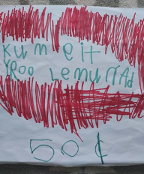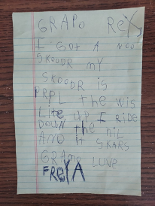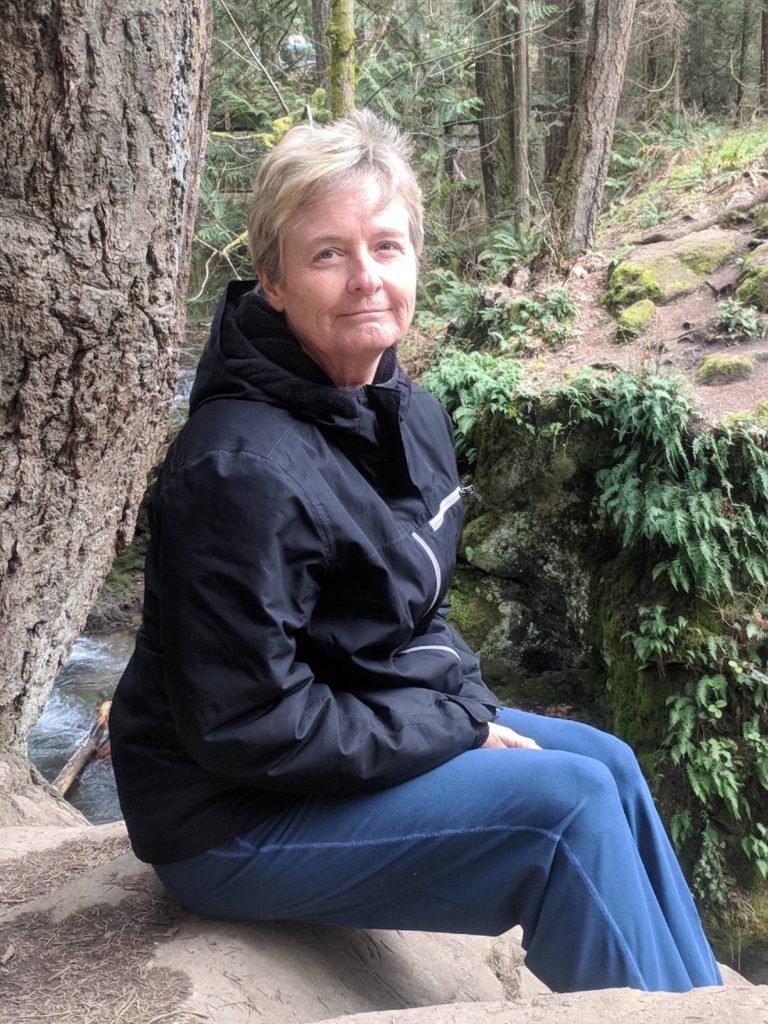Introduction
Recently I was reading a powerful blog, “Showing Young Readers How to Navigate the Phases of Word Reading,” by Jan Burkins and Kari Yates, authors of Shifting the Balance: 6 Ways to Bring the Science of Reading into the Balanced Literacy Classroom, about Linnea Ehri’s phases of word reading development (1995, 2005, 2017). This blog spoke so clearly to my role as a grandmother as well as my work with Collaborative Classroom. As I read, I saw my granddaughters, Freya (6) and Lyra (5), in each word reading stage. I also could see Being a Reader™, SIPPS®, and Being a Writer™ effectively reflected within each phase.
Pre-Alphabetic Phase
The first stage Ehri describes is called the pre-alphabetic phase. During this time, a child has little to no knowledge of the alphabetic principle, or the fact that letters and letter combinations represent consistent speech sounds that make up words in a given language.
However, a child in this stage is often beginning to learn about our world by using other cues to make sense of print. During this time, a child may notice the Golden Arches in front of a certain fast-food restaurant and seem to be reading as she shouts, “McDonald’s!” Little Lyra can tell me when to turn when we sneak off for French fries by locating these well-known Arches, but we are still working on the fact that the m in mom says (m).
She also knows how to find Dairy Queen when we are in the mood for a treat but is still working on the letter name for q. When pointing out the word “mom” in a bedtime story, she will tell me it reads Amy, her mother’s name. She has learned that this letter combination, a-m-y, represents her mother, while she really knows very little about letter sounds.
During this phase in early kindergarten, during Being a Reader whole-group lessons, students are working hard to learn the letter names. Students are also learning print concepts in shared reading lessons, along with some early sight words, so that we can launch into small-group reading which all leads us to the next phase.
Partial Alphabetic Phase
During this stage, children begin to understand that letters have consistent sounds and they learn the sounds of each letter in the alphabet. This knowledge is not yet solidified, but, when encouraged to do so, children begin to use this emerging knowledge to decode the print in their world.
The summer after preschool has Lyra solidly working in this phase, with a tiny push from her doting educator of a grandmother! Lyra can recognize her dear grandpa’s name of Rex; however, anytime a word has an x in it, she thinks that word is “Rex”. She also notices when words start with l as in Lyra and often asks, “Is that my name?” She recognizes and can write the names of all of the people in her immediate family; we are using this knowledge to cement her letter naming as well as launch her understanding of the sound each letter can make.
When her big sister Freya was in the early months of kindergarten, she used her budding knowledge to trick her mother into saying something slightly naughty. Amy was busy with Lyra when Freya asked what letter made the (p) sound. Amy told her it was the letter p. Freya had recently learned the letter combination for the sound (oo) as she had learned to write “Boo” during October. She must have figured out the ending sound using the beginning sound. Then she told her mom to read what she had written. Both girls giggled delightedly as her mother read a word I have been trying to get the girls to stop saying ad nauseum. They even insisted on sending grandma a video of mom reading this potty word!
Effective instruction is crucial at this beginning stage of reading. If students did not get the letter names down during the initial whole-group reading instruction in Being a Reader, we will add this work to the first SIPPS lessons for striving readers. Just as important, we will teach a few high-frequency words so that students can read their first Little Blue Books. We also will begin to teach the letter sounds of the consonants (s), (n), (t), (m) and the short vowel for (a) as well as orally blending and segmenting sounds in words.
This instruction is all in the hopes of moving students into the full alphabetic phase where they can sound out many c-v-c words in order to read even more challenging decodable readers. Being a Reader early Small Group Reading sets teaches many of the same skills but in a fashion more appropriate for students who are moving at a typical year-long trajectory.
If all goes well, this leads us into the next stage, which is my absolute favorite.
Full Alphabetic Phase
This is the stage where—as Burkins and Yates (2023) state— “…our young navigators can find their way through the written words, not around them…they are careful and conscious as they work across words.”
If instruction in this stage is following the Science of Reading, children will spend much time learning to decode c-v-c words, learning to read and spell a number of high-frequency words, continuing to work on segmenting and blending words in phonemic awareness activities, and practicing writing c-v-c as well as high-frequency words in guided spelling. They will not be pushed to read quickly but rather encouraged to methodically look through and sound all of the parts in words in order to store an orthographic map of these words in their brain.
They will not be pushed to read quickly but rather encouraged to methodically look through and sound all of the parts in words in order to store an orthographic map of these words in their brain.
This will be followed by little readers that help them practice these concepts in connected text so that they immediately see the connection between the skills they are learning and making meaning within the context of a story. This systematic instruction is seen in SIPPS Beginning lessons as well as the first three sets of Being a Reader Small-Group Reading.
In the summer after kindergarten, Freya was well into this phase. The part that delights me the most about this phase is the control a child develops over putting their thoughts into writing when allowed and encouraged to do so. The image below is a sign Freya made unassisted for our recent lemonade stand.

And a recent letter to her Grandpa Rex:

The note she wrote for me to share at a professional learning session this winter shows her budding personality as well as the strong sense of humor she has inherited from her grandmother: dont lisun to my gramo cuz she shavs her chin.
The aspect I love the most about these writing samples is that we can quickly see what Freya knows and what she is ready to learn next (including not sharing private information about her grandmother!).
The aspect I love the most about these writing samples is that we can quickly see what Freya knows and what she is ready to learn next.
Being a Writer encourages beginning and early writers to practice their reading skills by expressing the stories of their lives using their developing phonics and high-frequency word knowledge. These fully articulated lessons encourage students to move from using pictures with letter labels to tell the stories of their lives (pre- and partial alphabetic phase) to phonetic spelling such as Freya’s samples above (partial to full alphabetic phase) and finally to the conventional spelling seen in the consolidated and automatic phases. Being a Reader Small-Group Sets 4 and 5 as well as SIPPS Extension Level instruct students in vowel teams and beginning two-syllable word work in order to move children to the consolidated phase.
Consolidated Alphabetic Phase
I look forward to watching Freya followed by Lyra move to this next phase where children begin to use word chunks such as blends, vowel combinations, and syllables to decode print. In this phase, reading becomes less labored and more fluent as students recognize many letter patterns from the orthographic maps stored in their brains. They no longer need to sound through each and every letter and can analyze words by syllables. Second graders will often be seen somewhere within this phase. Being a Reader reinforces this instruction in the multisyllabic work found in Word Study starting in second grade and proceeding to more challenging levels all the way through fifth grade. SIPPS Challenge Level guides those who need extra support in this multisyllabic work. For older readers (grades 4–12) who have missed instruction or gotten stuck in a much earlier phase, SIPPS Plus is effective in catching them up.
The Automatic Phase
Burkins and Yates (2021) share that in this phase “…the travel is easy. Very little decoding-or arduous map reading-is required at all.”
Here is where students can read easily, fluently, and hopefully voraciously. This is the phase where Lyra, Freya, and I will curl up and journey through classics such as Charlotte’s Web and exciting newer novels like Wonder. I look forward to starting these books and letting them take over the reading as we journey from our couch to lands beyond.
Oh, the places we will go…
***
About Kathy King-Dickman

Kathy King-Dickman is a retired Colorado teacher with more than 30 years of classroom experience in kindergarten through eighth grade. She is a Professional Learning Lead Consultant for Collaborative Classroom. Learn more about Kathy.
References
Burkins, J. & Yates. K. 2021. Shifting the Balance: 6 Ways to Bring the Science of Reading into the Balanced Literacy Classroom. Portland, ME: Stenhouse.
Burkins, J. & Yates, K. 2023. “Showing Young Readers How to Navigate the Phases of Word Reading (Part 1): A Journey Through Ehri’s Phases.” https://thesixshifts.com/2023/06/showing-young-readers-how-to-navigate-the-phases-of-word-reading-part-1-a-journey-through-ehris-phases/
Ehri, Linnea C. 1995. “Phases of Development in Learning to Read Words by Sight.” Journal of Research in Reading Research 18 (2): 116–125.
Ehri, Linnea C. 2005a. “Learning to Read Words: Theory, Findings, and Issues.” Scientific Studies of Reading, 9 (2): 167–188. doi: 10.1207/s1532799xssr0902_4.
Ehri, Linnea C. 2005b. “Development of Sight Word Reading: Phases and Findings.” In M. J. Snowling and C. Hume (Eds.), The Science of Reading: A Handbook,135–154. Oxford, UK: Blackwell.
Ehri, Linnea C. 2017. “Orthographic Mapping and Literacy Development Revisited.” In Theories of Reading Development, edited by K. Cain, D. L. Compton, and R. K. Parrila, 169–190. Amsterdam, The Netherlands: John Bejamins, doi: 10.1075/swll.15.08ehr.
Palacio, R.J. Wonder. 2012. New York: Alfred A. Knopf.
White, E.B. (1952) Charlotte’s Web. New York:Harper and Brothers.
Related:
Get our White Paper: What’s Settled About the Science of Reading?
